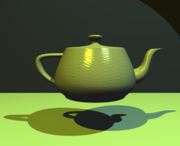Teapot
2008/9 Schools Wikipedia Selection. Related subjects: Everyday life

A teapot is a vessel used for steeping tea leaves or an herbal mix in near-boiling water. Tea may be either in a tea bag or loose, in which case a tea strainer will be needed to catch the leaves inside the teapot when the tea is poured. Teapots usually have an opening with a lid at their top, where the tea and water are added, a handle for holding by hand and a spout through which the tea is served. Some teapots have a strainer built-in on the inner edge of spout. A small hole in the lid is necessary for air access inside to stop the spout from dripping and splashing when tea is poured. In modern times, a tea cosy may be used to enhance the steeping or to prevent the contents of the teapot from cooling too rapidly. A tea connoisseur will warm the teapot by rinsing it with boiling water and then draining it completely before making tea.
History of the teapot
The teapot probably derived originally from the ceramic kettles and wine pots which were made in bronze and other metals and were a feature of Chinese cultural life for thousands of years. The earliest example of a teapot that has survived to this day seems to be the one in the Flagstaff House Museum of Teaware It has been dated to 1513 and attributed to Gongchun
From the end of the 17th century tea was shipped from China to Europe as part of the export of exotic spices and luxury goods. The ships that brought the tea also carried porcelain teapots. The majority of these teapots were painted in blue and white underglaze. Porcelain being completely vitrified will withstand sea water without damage, so the teapots were packed below deck whilst the tea stayed on top in the dry.
Tea drinking in Europe was initially the preserve of the upper classes since it was very expensive. Porcelain teapots were particularly desirable because porcelain could not be made in Europe at that time. It wasn't until 1765 that William Cookworthy devised a way of making porcelain and founded a works at Plymouth UK for the production of a porcelain similar to the Chinese. When European potteries began to make their own tea wares they were naturally inspired by the Chinese designs.
Teapot care
Unglazed teapots are recommended not to be washed in a dishwasher or soapy water. They should be rinsed with warm water only and left upside down to dry. If unglazed teapot is used with different teas, it is advisable not to mix them and have dedicated teapots for every tea variety to preserve the taste. Natural tannin sediment in an unglazed teapot should be left untouched as over time it will enhance the flavouring without flaking off as in a glazed teapot. To remove build-up of tannin in a glazed teapot one can use boiling water and a couple teaspoons of baking soda and leave it overnight, then wipe and rinse to desired state.
Teapots in non-teamaking contexts
A teapot has a rather peculiar shape, and its fame has often nothing to do with its primary function.
- The Utah Teapot is a standard reference object of the computer graphics community, comparable to Hello, World for its popularity. It is included as a graphics primitive in many graphics packages, including AutoCAD, POV-Ray, OpenGL, Direct3D, and 3D Studio Max.
- Along similar lines, in the "3d pipes" screensaver, under Windows, a Utah teapot appears at pipe junctions periodically.
- Russell's teapot, a skeptic analogy refuting the unfalsifiability of religious claims devised by Bertrand Russell and further expanded upon by Richard Dawkins.
- The teapot has been featured in the nursery rhyme, " I'm a Little Teapot".
- The constellation of Sagittarius famously resembles a teapot.
In architecture
- In 2004, a Malaysian cult called the Sky Kingdom erected a pink teapot 35 feet tall on its property as part of its own private symbolism .As part of a crackdown on the sect in August 2005 bulldozers and heavy machinery were sent in to tear down the structure.
- The (purported) world's largest architectural teapot is to be found in Ohio .In 1938 The Chester Teapot was constructed by William "Babe" Devon. The Teapot started its life as a gigantic wooden hogshead barrel for a Hire's Root Beer advertising campaign. Devon purchased the barrel in Pennsylvania and had it shipped to Chester where it was set up on Carolina Avenue, which is also State Route 2. A spout and handle were added at this time and the wooden barrel was covered with tin to form the teapot's shape. A large glass ball was placed on top to make the knob of the "lid". The Teapot stood in front of Devon's pottery outlet store. Local teenagers were hired to run a concession and souvenir stand which was set up inside the Teapot.





